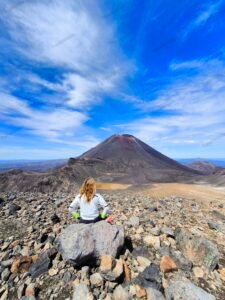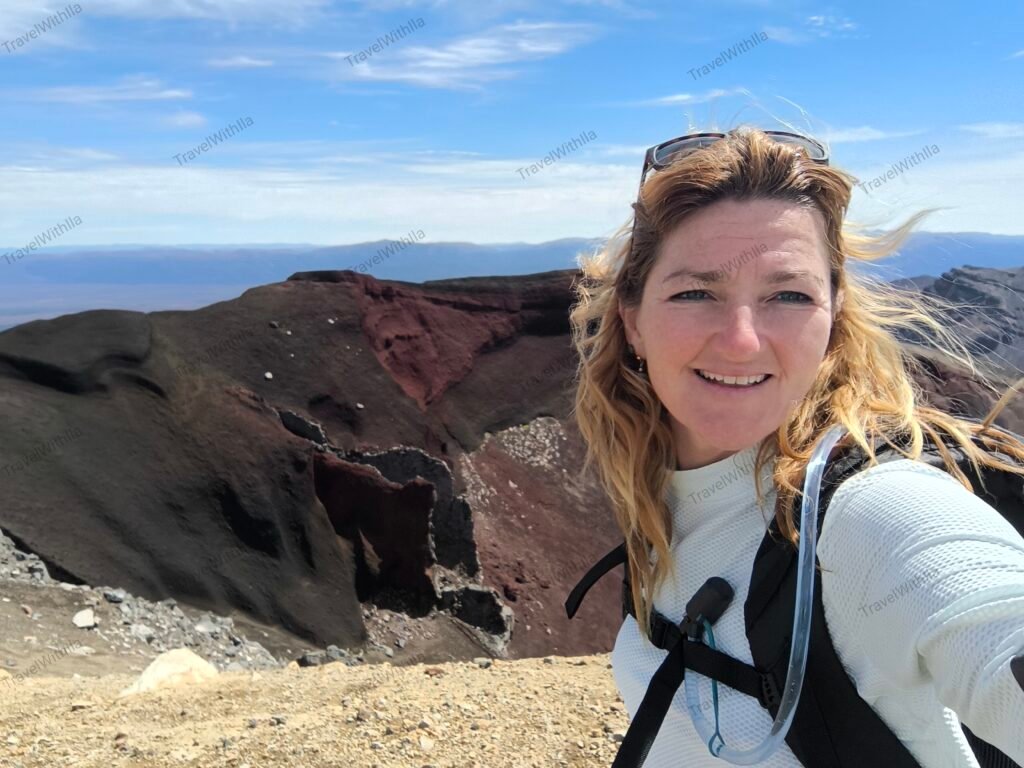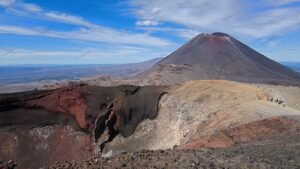
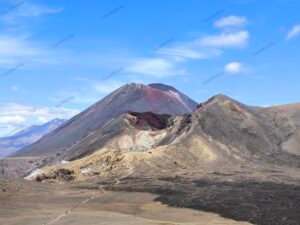
Today, I’m taking you with me to New Zealand!
The Tongariro Alpine Crossing is undoubtedly one of the most impressive treks I’ve ever done. Walking through this dramatic volcanic landscape, with its steaming vents, ancient lava flows, and vivid crater lakes, feels like stepping onto another planet.
21 km of hiking through another world
As you walk, your gaze drifts left and right, captivated by the 360° views. You are completely surrounded by a lunar landscape, where colors and shades shift with every step.
Reaching the top of the crater is an unforgettable moment—its contrast of deep black and intense red is breathtaking and hypnotic. Standing there, it’s impossible not to think of The Lord of the Rings. Everyone feels a little like Frodo in that moment.
I didn’t have the One Ring hanging around my neck, but my 5kg backpack on the steep ascent made me feel the weight of the journey! And just as I reached the very place where Frodo finally let go of the Ring, I spotted a lava rock shaped like a heart. I picked it up, made a wish, and gently placed it on the pile of stones left by other hikers—hoping that the volcanic energy of this sacred place would bring it to life.
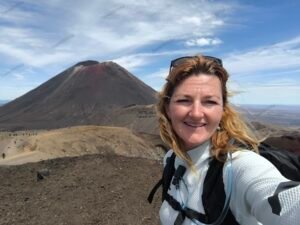

The Descent: A Test of Balance and Awe
From there, the trail takes a steep and slippery descent. I lost count of how many people I saw rolling down the path.
But once the descent is over, you arrive at one of the most sublime sights of the trek: the Emerald Lakes, vibrant turquoise lagoons formed inside volcanic craters. Their bright colors stand in stark contrast with the surrounding moonscape, making it a place you never want to leave.
I kept walking, but my eyes remained locked on Tongariro and its crater. A fellow hiker passing by smiled and said, “You look like you’re in a trance!” And I was. Completely.
A must-do trek, at least once in a lifetime.
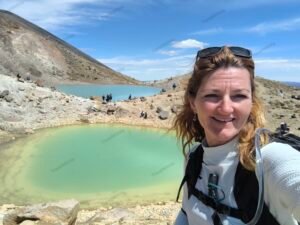

How to Organize Your Hike: Practical Tips
I started the trek at 8:30 AM from the parking lot and finished at 4:00 PM, stopping many times to take millions of photos and videos!
Logistics can be tricky, so here are the tips I wish I had known beforehand, along with my experience, which turned out exactly as expected.
Private cars are not allowed at the trailhead, and parking areas are far away. So, you need to use to the Shuttle System.
The official system relies on pre-booked shuttles. You park in designated areas, take a shuttle to the starting point, and once you finish, you call the shuttle again to bring you back to your car. However, you need to stick to their schedule, which can be stressful, as well as what if you cannot call?! Moreover, it’s not so nice waiting for a shuttle coming at the end of many hours hiking, when you’re tired and you want to coma back sooner as possible.
A Better Alternative? What I did instead, that I think it’s smarter: I parked directly at the endpoint of the trail and took a one-way shuttle to the start. That way, once I finished, my car was already waiting for me—no need to rush, no need to wait for a shuttle. Just freedom to enjoy the experience at my own pace.
Essential Gear:
- Bring enough food and at least 2 liters of water—there are no refill stations along the way.
- Pack layers, as weather conditions can change rapidly.
- Take your trash home! Respect the park and its fragile ecosystem.
Toilets: There are restrooms along the trail, so no need to worry about that!
The Challenge of Over-Tourism
The Tongariro Alpine Crossing is New Zealand’s most popular hike, with hundreds of people walking it every single day.
I’ll be honest—I don’t love hiking in crowds. I prefer to be alone with nature, without overhearing conversations that make the trail feel more like a marketplace than a wilderness experience. But beyond personal preference, the bigger question is:
What impact does this level of tourism have on such a fragile ecosystem?!
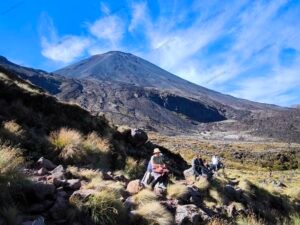
Sustainability and Conservation Efforts
New Zealand’s Department of Conservation (DOC), together with Ngāti Tūwharetoa, the local Māori iwi, is working to protect the environmental and cultural heritage of Tongariro National Park with key challenges and solutions:
- Waste Management
New toilets have been installed, but maintaining them requires helicopters to remove waste, increasing carbon emissions. A more sustainable solution is still needed.
- Trail Maintenance
Natural erosion, worsened by climate change, already damages the trail. Heavy foot traffic accelerates this process, requiring constant funding for repairs.
- The New Booking System
Since October 2023, visitors must book their hike online. There’s no limit to bookings, and it’s a free service, but this system helps track visitor numbers, provide direct information, and promote responsible travel practices.
How to Be a More Responsible Hiker
If you’re planning to hike the Tongariro Alpine Crossing, here’s how to reduce your impact and ensure this incredible place remains protected:
✅ Book in advance and check the latest conservation guidelines.
✅ Take all your trash with you—leave no trace!
✅ Stick to designated trails to avoid damaging fragile ecosystems.
✅ Respect Māori heritage—this land is sacred.
✅ Support local businesses that promote sustainable tourism.
Remember to live the Tongariro Alpine Crossing in responsible travel way. Every step we take on this ancient land comes with a responsibility:
To tread lightly
To respect its cultural and environmental heritage
To ensure that future generations can experience its magic just as we do today
Would you like to hike the Tongariro Alpine Crossing?
Read my full New Zealand reportage in my Travel Magazine, where I share my personal experience and insights on sustainable and responsible tourism.
💌 Ask for your copy now!
